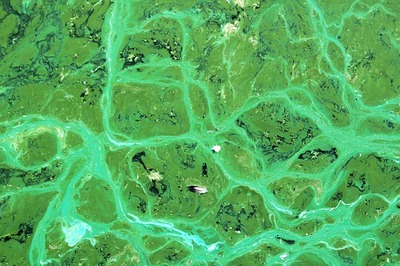Wisconsin DNR Reminds Beachgoers to Lookout for Blue-Green Algae
Saturday, July 17th, 2021 -- 8:00 AM

The Wisconsin Department of Natural Resources is reminding beachgoers and their pets to watch for blue-green algae and know the risks.
Blue-green algae can cause illness if swallowed or inhaled in water droplets, or irritation if rubbed on the skin under clothing. Blue-green algae, or cyanobacteria, are photosynthetic bacteria often called "pond scum."
Blue-green algae are most often green but can also be blue, tan, reddish-purple or brown. Blue-green algae generally grow in lakes, ponds and slow-moving streams when the water is warm and enriched with nutrients like phosphorus or nitrogen.
When environmental conditions are just right, blue-green algae can increase in number. Most species are buoyant and will float to the surface, where they form scum layers or floating mats known as a "blue-green algae bloom."
In Wisconsin, blue-green algae blooms generally occur between mid-June and late September, although in rare instances, blooms have been observed in winter, even under the ice.
Since most lakes in Wisconsin are not tested for blue-green algae, it is important to know what it looks like and always assess conditions before swimming.
Stay safe by following best practices including:
-Do not swim in water that looks like "pea soup," green or blue paint, or that has a scum layer or puffy blobs floating on the surface;
-Do not boat, water ski, etc., over such water, people can be exposed through inhalation;
-Do not let children play with scum layers, even from shore;
-Do not let pets or livestock swim in, or drink, waters experiencing blue-green algae blooms;
-Always take a shower after encountering any surface water, whether or not a blue-green algae bloom appears to be present, surface waters may contain other species of potentially harmful bacteria and viruses;
-And try to avoid swallowing lake water, no matter how clean it looks, since it may have bacteria, viruses, or parasites in it that could make you sick.
Blue-green algae can have harmful effects on humans and pets. However, because dogs love to spend time in the water, they are not deterred by surface scum and often swallow a lot of water while swimming.
If they consume large quantities of blue-green algae when they drink the water, and if those blue-green algae happen to be producing toxin(s), the animals can become very ill, and even die.
Symptoms of blue-green algal toxin poisoning may range from lethargy and loss of appetite to seizures, vomiting and convulsions. Dogs are particularly susceptible to blue-green algal poisoning because scums can attach to their coats and be swallowed during self-cleaning.
To keep dogs safe, choose the clearest water possible for dogs to swim in and keep dogs out of areas with accumulations of blue-green algae or any dense particulate matter.
Follow these tips to keep pets safe including:
-Do not let pets swim in, or drink, waters experiencing blue-green algae blooms or noticeably green water;
-Keep dogs out of shallow, stagnant waters where blue-green algae may be growing on the bottom and dislodged by disturbance, if people shouldn't swim there, dogs shouldn't either;
-Always offer fresh, clean water for pets to drink instead of lake water;
-Always wash dogs off with clean water immediately after they swim, so they don't lick any algae from their fur;
-Supervise pets when they are outside so they don't eat algal scum accumulated on the shore, floating mats of algae or drink lake water;
-If a pet eats grass, avoid using lake water for lawn irrigation if blooms are present;
-If there's any doubt about what is in the water, keeping pets out is the safest course of action.
Symptoms of water intoxication (from swallowing too much water) and heatstroke in dogs include vomiting, diarrhea, lethargy, and loss of coordination. Give dogs plenty of breaks from swimming and retrieving in lakes, avoid having dogs bite at splashed water as a game and use flat objects for retrieval instead of balls.
Always provide shade and fresh, clean water to drink. The public is encouraged to report significant blue-green algae blooms to the DNR at [email protected].
Please include the location of the bloom, the name of the water body, nearest town, county, the size and duration of the bloom and overall and close-up photographs for verification. The DNR is unable to test all reported blooms.
For more information on blue-green algae, including symptoms of exposure and environmental concerns, visit the DNR Blue-Green Algae webpage. More information is also available via the Wisconsin Department of Health Services.
Feel free to contact us with questions and/or comments.




